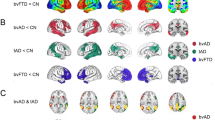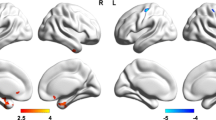Abstract
The ability to reject an automatic tendency, i.e. inhibition, has been linked to the prefrontal cortex, but its neural underpinnings are still controversial. Neurodegenerative diseases represent an interesting model to explore this issue, given its frequent impairment in these disorders. We investigated the inhibitory impairment and its neural basis using four different tests, which evaluate the presence of inhibitory dysfunction (Stroop test, Hayling test, and two graphical perseveration tests), and assessed their correlation with brain metabolism using 18F-fluorodeoxyglucose positron emission tomography in a group of 76 participants with behavioral variant frontotemporal dementia (bvFTD), Alzheimer’s disease (AD), amyotrophic lateral sclerosis (ALS) and healthy controls (HC). Inhibition impairment was more frequent in bvFTD and AD, than ALS and HC. AD and bvFTD only differed in the strategy used in Hayling test, and the frequency of impairment in graphical perseveration tests. Correlation between inhibition tests was moderate. The Stroop test correlated with several regions of the frontal and parietal lobes, mainly on the left side. Hayling test correlated with almost all regions of the frontal lobe and, especially, with the orbitofrontal cortex. Some differences in the impaired regions in each disease were found. Inhibition ability was mainly impaired in bvFTD and AD, and it correlated with the bilateral frontal lobe metabolism. There were certain particularities according to the specific task and patients evaluated. These dissimilarities may support the concept of inhibition as a multidimensional construct, with the involvement of common and divergent neural mechanisms.


Similar content being viewed by others
References
Aron, A. R., Fletcher, P. C., Bullmore, E. T., Sahakian, B. J., & Robbins, T. W. (2003). Stop-signal inhibition disrupted by damage to right inferior frontal gyrus in humans. Nature Neuroscience, 6(2), 115–116.
Aron, A. R., Robbins, T. W., & Poldrack, R. A. (2014). Inhibition and the right inferior frontal cortex: one decade on. Trends in Cognitive Sciences, 18(4), 177–185. https://doi.org/10.1016/j.tics.2013.12.003.
Bari, A., & Robbins, T. W. (2013). Inhibition and impulsitivy: behavioral and neural basis of response control. Progress in Neurobiology, 108, 44–79. https://doi.org/10.1016/j.pneurobio.2013.06.005.
Bayard, S., Gély-Nargeot, M.C., Raffard, S., Guerdoux-Ninot, E., Kamara, E., Gros-Balthazard, F., … Moroni, C.; Collège des Psychologues Cliniciens specializes en Neuropsychologie du Languedoc Rousillon (CPCN-Languedoc Rousillon). (2017). French version of the Hayling Sentence Completion Test, Part I: normative data and guidelines for error scoring. Archives of Clinical Neuropsychology, 7, 1–7. https://doi.org/10.1093/arclin/acx010.
Belleville, S., Rouleau, N., & Van der Linden, M. (2006). Use of the Hayling task to measure inhibition of prepotent responses in normal aging and Alzheimer’s disease. Brain and Cognition, 62(2), 113–119.
Bettcher, B.M., Mungas, D., Patel, N., Elofson, J., Dutt, S., Wynn, M., … Kramer, J.H. (2016). Neuroanatomical substrates of executive functions: Beyond prefrontal structures. Neuropsychologia, 85, 100–109. https://doi.org/10.1016/j.neuropsychologia.2016.03.001.
Bracco, L., Bessi, V., Piccini, C., Mosconi, L., Pupi, A., & Sorbi, S. (2007). Metabolic correlates of executive dysfunction. Different patterns in mild and very mild Alzheimer’s disease. Journal of Neurology, 254, 1052–1065.
Brooks, B. R., Miller, R. G., Swash, M., Munsat, T. L., & World Federation of Neurology Research Group on Motor Neuron Diseases. (2000). El Escorial revisited: revised criteria for the diagnosis of amyotrophic lateral sclerosis. Amyotrophic Lateral Sclerosis and Other Motor Neuron Disorders, 1(5), 293–299.
Burgess, P., & Shallice, T. (1996). Response supression, initiation and strategi use following frontal lobe lesions. Neuropsychologia, 34(4), 263–272.
Cipolotti, L., Spanò, B., Healy, C., Tudor-Sfetea, C., Chan, E., White, M., … Bozzali, M. (2016). Inhibition processes are dissociable and lateralized in human prefrontal cortex. Neuropsychologia, 93(Pt A), 1–12. https://doi.org/10.1016/j.neuropsychologia.2016.09.018.
Collette, F., Amieva, H., Adam, S., Hogge, M., Van der Linden, M., Fabrigoule, C., & Salmon, E. (2007). Comparison of inhibitory functioning in mild Alzheimer’s disease and frontotemporal dementia. Cortex, 43(7), 866–874.
Della Rosa, P.A., Cerami, C., Gallivanone, F., Prestia, A., Caroli, A., Castiglioni, I., … Perani, D.; EADC-PET Consortium. (2014). A standardized [18F]-FDG-PET template for spatial normalization in statistical parametric mapping of dementia. Neuroinformatics, 12(4), 575–593. https://doi.org/10.1007/s12021-014-9235-4.
Dermody, N., Hornberger, M., Piguet, O., Hodges, J. R., & Irish, M. (2016). Prospective memory impairments in Alzheimer’s disease and behavioral variant frontotemporal dementia: clinical and neural correlates. Journal of Alzheimer's Disease, 50(2), 425–441. https://doi.org/10.3233/JAD-150871.
Fernández-Matarrubia, M., Matías-Guiu, J. A., Moreno-Ramos, T., & Matías-Guiu, J. (2014). Behavioral variant frontotemporal dementia: clinical and therapeutic approaches. Neurología, 29(8), 464–472. https://doi.org/10.1016/j.nrl.2013.03.001.
Fernández-Matarrubia, M., Matías-Guiu, J. A., Cabrera-Martín, M. N., Moreno-Ramos, T., Valles-Salgado, M., Carreras, J. L., & Matías-Guiu, J. (2017). Different apathy clinical profile and neural correlates in behavioral variant frontotemporal dementia and Alzheimer’s disease. International Journal of Geriatric Psychiatry, 33, 141–150. https://doi.org/10.1002/gps.4695.
Friedman, N. P., & Miyake, A. (2004). The relations among inhibition and interference control functions: a latent-variable analysis. Journal of Experimental Psychology. General, 133(1), 101–135.
Golden, C. J. (1978). Stroop color and word test. A manual for clinical and experimental uses. Chicago: Stoelting.
Goldstein, S., & Naglieri, J. A. (2014). Handbook of executive functioning. New York: Springer-Verlag.
Hornberger, M., Savage, S., Hsieh, S., Mioshi, E., Piguet, O., & Hodges, J. R. (2010). Orbitofrontal dysfunction discriminates behavioral variant frontotemporal dementia from Alzheimer’s disease. Dementia and Geriatric Cognitive Disorders, 30(6), 547–552. https://doi.org/10.1159/000321670.
Hornberger, M., Geng, J., & Hodges, J. R. (2011). Convergent grey and white matter evidence of orbitofrontal cortex changes related to disinhibition in behavioral variant frontotemporal dementia. Brain, 134(Pt 9), 2502–2512. https://doi.org/10.1093/brain/awr173.
Martyr, A., Boycheva, E., & Kudlicka, A. (2017). Assessing inhibitory control in early-stage Alzheimer’s and Parkinson’s disease using the Hayling sentence completion test. Journal of Neuropsychology. https://doi.org/10.1111/jnp.12129.
Matías-Guiu, J. A., Pytel, V., Cabrera-Martín, M. N., Galán, L., Valles-Salgado, M., Guerrero, A., Moreno-Ramos, T., Matías-Guiu, J., & Carreras, J. L. (2016). Amyloid- and FDG-PET imaging in amyotrophic lateral sclerosis. European Journal of Nuclear Medicine and Molecular Imaging, 43(11), 2050–2060. https://doi.org/10.1007/s00259-016-3434-1.
Matías-Guiu, J. A., Cuetos, F., Cabrera-Martín, M. N., Valles-Salgado, M., Moreno-Ramos, T., Carreras, J. L., & Matías-Guiu, J. (2017a). Reading difficulties in primary progressive aphasia in a regular language-speaking cohort of patients. Neuropsychologia, 101, 132–140. https://doi.org/10.1016/j.neuropsychologia.2017.05.018.
Matías-Guiu, J. A., Cabrera-Martín, M. N., Valles-Salgado, M., Pérez-Pérez, A., Rognoni, T., Moreno-Ramos, T., et al. (2017b). Neural basis of cognitive assessment in Alzheimer disease, amnestic mild cognitive impairment, and subjective memory complaints. The American Journal of Geriatric Psychiatry, 25(7), 730–740. https://doi.org/10.1016/j.jagp.2017.02.002.
McKhann, G.M., Knopman, D.S., Chertkow, H., Hyman, B.T., Jack, C.R. Jr, Kawas, C.H., … Phelps, C.H. (2011). The diagnosis of dementia due to Alzheimer’s disease: recommendations from the National Institute on Aging-Alzheimer’s Association Workgroups on diagnostic guidelines for Alzheimer’s disease. Alzheimers Dement, 7(3), 263–269. https://doi.org/10.1016/j.jalz.2011.03.005.
Nash, S., Henry, J. D., McDonald, S., Martin, I., Brodaty, H., & Peek-O’Leary, M. A. (2007). Cognitive disinhibition and socioemotional functioning in Alzheimer’s disease. Journal of the International Neuropsychological Society, 13(6), 1060–1064.
O’Callaghan, C., Naismith, S. L., Hodges, J. R., Lewis, S. J. G., & Hornberger, M. (2013). Fronto-striatal atrophy correlates of inhibitory dysfunction in Parkinson’s disease versus behavioral variant frontotemporal dementia. Cortex, 49(7), 1833–1843. https://doi.org/10.1016/j.cortex.2012.12.003.
Peña-Casanova, J., Quiñones-Úbeda, S., Gramunt-Fombuena, N., Quintana, N., Aguilar, M., Molinuevo, J.L., … Blesa, R.; NEURONORMA Study Team. (2009). Spanish Multicenter Normative Studies (NEURONORMA Project): norms for the Stroop color-word interference test and the Tower of London-Drexel. Archives of Clinical Neuropsychology, 24(4), 413–429. https://doi.org/10.1093/arclin/acp043.
Pérez-Pérez, A., Matías-Guiu, J.A., Cáceres-Guillén, I., Rognoni, T., Valles-Salgado, M., Fernández-Matarrubia, M., … Matías-Guiu, J. (2016). The Hayling test: development and normalization of the Spanish version. Archives of Clinical Neuropsychology, 31(5), 411–419. https://doi.org/10.1093/arclin/acw027.
Picton, T. W., Stuss, D. T., Alexander, M. P., Shallice, T., Binns, M. A., & Gillingham, S. (2007). Effects of focal frontal lesions on response inhibition. Cerebral Cortex, 17(4), 826–838.
Rascovsky, K., Hodges, J.R., Knopman, D., Mendez, M.F., Kramer, J.H., Neuhaus. J., … Miller, B.L. (2011). Sensitivity of revised diagnostic criteria for the behavioral variant of frontotemporal dementia. Brain, 134(Pt 9), 2456–2477. https://doi.org/10.1093/brain/awr179.
Robinson, G. A., Cipolotti, L., Walker, D. G., Biggs, V., Bozzali, M., & Shallice, T. (2015). Verbal suppression and strategy use: a role for the right lateral prefrontal cortex? Brain, 138, 1084–1096.
Robinson, G. A., Walker, D. G., Biggs, V., & Shallice, T. (2016). When does a strategy intervention overcome a failure of inhibition? Evidence from two left frontal brain tumour cases. Cortex, 79, 123–129.
Schroeter, M. L., Vogt, B., Frisch, S., Becker, G., Barthel, H., Mueller, K., Villringer, A., & Sabri, O. (2012). Executive deficits are related to the inferior frontal junction in early dementia. Brain, 135(Pt 1), 201–215. https://doi.org/10.1093/brain/awr311.
Shim, S. H., Kang, H. S., Kim, J. H., & Kim, D. K. (2016). Factors associated with careigiver burden in dementia: 1-year follow-up study. Psychiatry Investigation, 13(1), 43–49. https://doi.org/10.4306/pi.2016.13.1.43.
Thierry, A. M., Glowinski, J., Goldman-Rakic, & Christen, Y. (1994). Motor and cognitive functions of the prefrontal cortex. Berlin: Springer.
Tzourio-Mazoyer, N., Landeau, B., Papathanassiou, D., Crivello, F., Etard, O., Delcroix, N., … Joliot, M. (2002). Automated anatomical labeling of activation in SPM using a macroscopic anatomical parcellation of the MNI MRI single-subject brain. NeuroImage, 15 (1), 272–289.
Varrone, A., Asenbaum, S., Vander Borght, T., Booij, J., Nobili, F. Någren, K., … Van Laere, K; European Association of Nuclear Medicine Neuroimaging Committee. (2009). EANM procedure guidelines for PET brain using [18F]FDG, version 2. European Journal of Nuclear Medicine and Molecular Imaging, 36(12), 2103–2110. https://doi.org/10.1007/s00259-009-1264-0.
Volle, E., de Lacy Costello, A., Coates, L. M., McGuire, C., Towgood, K., Gilbert, S., Kinkingnehun, S., McNeil, J. E., Greenwood, R., Papps, B., van den Broeck, M., & Burgess, P. W. (2012). Dissociation between verbal response initiation and suppression after prefrontal lesions. Cerebral Cortex, 22, 2428–2440.
Yun, J. Y., Lee, D. Y., Seo, E. H., Choo, I. H., Park, S. Y., Kim, S. G., & Woo, J. I. (2011). Neural correlates of Stroop performance in Alzheimer’s disease: a FDG-PET study. Dementia Geriatric Cognitive Disorders Extra, 1(1), 190–201. https://doi.org/10.1159/000329517.
Author information
Authors and Affiliations
Corresponding author
Ethics declarations
Conflict of interest
The authors declare than they have no conflict of interest.
Research involving human participants
All procedures performed were in accordance with the ethical standards of the institutional research committee and with the 1964 Helsinki declaration and its later amendments.
Inform consent
Informed consent was obtained from all individual participants included in the study.
Rights and permissions
About this article
Cite this article
Matías-Guiu, J.A., Cabrera-Martín, M.N., Valles-Salgado, M. et al. Inhibition impairment in frontotemporal dementia, amyotrophic lateral sclerosis, and Alzheimer’s disease: clinical assessment and metabolic correlates. Brain Imaging and Behavior 13, 651–659 (2019). https://doi.org/10.1007/s11682-018-9891-3
Published:
Issue Date:
DOI: https://doi.org/10.1007/s11682-018-9891-3




